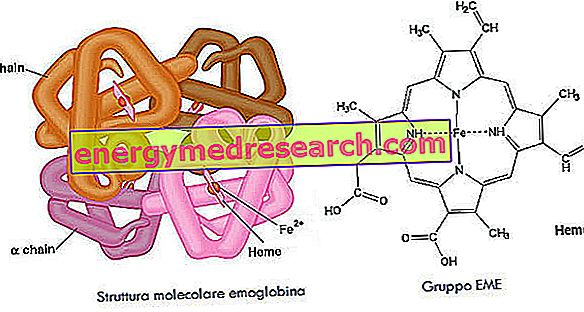Generality
The female genital apparatus is the complex of anatomical organs and structures, which - in women - aims to control the mechanism of reproduction, from the production of egg cells to that of sex hormones.
In describing the organization of the female genital apparatus, the anatomists divide the organs and anatomical structures into two categories, depending on whether they are inside or outside the human body.
The organs and anatomical structures located inside are: the vagina, the cervix, the uterus, the fallopian tubes and the ovaries.
The organs and anatomical structures placed outside, on the other hand, are: the mount of Venus, the labia majora, the labia minora, the Bartolini's glands and the clitoris.

What is the female genital system?
The female genital apparatus is the set of organs and anatomical structures, which, in the woman, is deputed to the production of egg cells and female sex hormones and, in general, to the whole reproduction mechanism (from the coupling to the maturation of the fetus).
Organization
The anatomists divide the organs and anatomical structures of the female genital apparatus into two categories: the internal organs and female genital elements and the external female organs and genital elements.
Among the internal organs and female genital elements are: the vagina, the cervix, the uterus, the fallopian tubes and the ovaries.
Among the organs and external female genital elements, however, are: the labia majora, the labia minora, the glands of Bartolini, the mount of Venus and the clitoris (less common, the clitoris). Taken together, all these elements take the anatomical name of vulva .
VAGINA
The vagina is the fibro-muscular channel that connects the uterus with the outside.
To be precise, it is in connection with the cervix, which represents the lower part of the uterus.
From the functional point of view, the vagina is the anatomical area responsible for housing the male sperm after ejaculation, on the occasion of a sexual relationship.
The term "vagina" comes from the Latin word "vagina", which means "sheath" or "sword sheath".
UTERUS
Representing the largest organ of the female genital apparatus, the uterus is a pear-shaped anatomical element whose purpose is to house the fetus during its pre-natal life.
From the anatomical point of view, the uterus is an organ with a strong muscular component, endowed with three important suspensory ligaments, known as: uterosacral ligament, round ligament and cardinal ligament.
In general, the role of the three ligaments is to keep the uterus in position and limit its range of motion.
Specifically, the uterosacral ligament serves to prevent excessive up and down movements of the uterus; the round ligament serves to avoid excessive backward movements of the uterus; finally, the cardinal ligament serves to prevent excessive forward and downward movements of the uterus.
In the womb, the anatomists recognize two parts: an upper one, which takes the name of the body and has the task of welcoming the future unborn child, and an inferior one, which is the already named cervix.
It is in the womb that the future unborn child takes place.
From the functional point of view, the uterus provides:
- Provide mechanical protection and nutrients to the embryo, first (from the 1st to the 8th week), and to the fetus, then (from the ninth week to the birth).
- Eliminate waste products, produced by the future unborn child, throughout his pre-natal life.
- Ensure fetal leakage at the end of pregnancy. This is possible thanks to the muscular component that characterizes the uterus and that allows the so-called contractions.
CERVICE UTERINA
The uterine cervix, also known as the cervix, is the narrow hollow portion with which the uterus terminates and connects the latter with the vagina.
The cervix has a cylindrical or conical shape.
Generally, about half of the cervix is visible to the naked eye, through the outer opening of the vagina.
FALLOPIAN TUBES
Two in number and symmetrical, the fallopian tubes are the tubular anatomical structures, which connect the ovaries to the uterus (precisely to the body of the uterus).
Of predominantly muscular nature, they house and orientate the egg cells released by the ovaries towards the uterus; moreover, if conception takes place when an egg cell is still inside them, they ensure the passage of the fertilized egg from where it resides towards the uterus.
In each fallopian tube, anatomists recognize 4 sections or areas:
- The infundibulum . It is the region closest to the ovaries and closely related to the so-called fimbria. Fimbria is a fringe of tissue, equipped with cilia, which facilitates the movement of the egg cells towards the fallopian tubes.
- The ampullary region . With its 6-7 cm extension, it is the longest region of the fallopian tubes. Thanks to the cilia on the inner wall, it facilitates the passage of the egg cells or of the fertilized eggs from the ovaries to the uterus
- The isthmic region . It represents the narrowest portion of the fallopian tubes and generally measures about 2-3 centimeters. It has a straight line.
It is also equipped with cilia, for the passage of egg cells or fertilized eggs.
- The intramural region . The terminal region of the fallopian tubes is also the shortest section.
It makes contact with the uterus, entering the myometrium (ie the uterus muscle).
At this level, the so-called utero-tubal junction takes place, ie the opening of the fallopian tubes at the level of the uterus.
The fallopian tubes have different synonyms. They are, in fact, also known as: salpingi, oviducts or uterine trumpets.
OVARIES
The ovaries (in the singular ovary, but also ovary or ovary) are the female gonads .
In human anatomy, the term gonads indicates the glands that produce gametes, or sex cells.
In number of two and similar in shape to a bean, the ovaries cover two extremely important functions:
- They produce the egg cell (or oocyte or oocyte ), which is the female gamete.
As you will see, for about half of the so-called menstrual cycle, each egg cell stops in the ovary and undergoes a fundamental maturation process.
At the end of the maturation phase, the so-called ovulation takes place, ie the release of the oocyte in the fallopian tubes.
- They secrete female sex hormones, estrogen and progesterone, which play an essential role in the development of secondary sexual characteristics and reproduction.
Together with the uterus, the ovaries can be considered, in their own right, the main organs of the female genital apparatus.
MONTE DI VENERE
Triangular in shape and with the apex turned downwards, the mount of Venus is a rounded mass of adipose tissue, located at the pubis and limited at the top by the hypogastrium and laterally by the inguinal folds. Compared to the other structures of the vulva, it dominates the labia majora.
Generally, the epidermis of the mount of Venus is thick and has sebaceous and sweat glands.
In prepubertal age, the mount of Venus is a glabrous anatomical region, ie without hair; with the onset of puberty and until the end of it begins to gradually cover itself with long hairs.
BIG LIPS
The big lips (or bigger lips ) are two obvious longitudinal skin folds, which extend downwards and backwards, starting from the mount of Venus up to the perineum.
- At the level of the mount of Venus, they form the so-called anterior vulvar commissure (NB: in anatomy, commessura identifies a junction between two parts of a structure).
- At the level of the perineum, exactly a few centimeters from the anus, they form the so-called inferior vulvar commissura (vulvar fork).
Composed mainly of fibro-elastic and fat-rich connective tissue, the two large lips have two faces each: one lateral (external) and one medial (internal).
The medial face of each large lip borders on the lateral face of the small ipsilateral lip; at the connection point, there is a groove known as an interlabial sulcus.
In adult women, labia majora measure on average 7-8 centimeters in length, 2-3 centimeters in width and 15-20 millimeters in thickness.
More pigmented than other parts of the body, they are home to sweat and sebaceous glands, the secretion of which acts as a sexual attraction.
With the onset of puberty, the labia majora begin to become covered with hair: the precise area in which these hairs grow is on the lateral face (therefore the medial face is glabrous).
After menopause, they become thinner, losing much of the adipose component and becoming thinner and floppy.
The function of the labia majora is to offer protection to the labia minora, the vaginal meatus and the external urethral orifice.
In humans, the big lips correspond to the scrotum.

SMALL LIPS
The small lips (or nymphs or minor lips ) are the two thin pinkish skin folds, which reside inside the two large lips (remember that the point of separation between large and small lips is the so-called interlabial groove).
They start just below the clitoris: here they give rise to two particular structures, known as the clitoral frenulum and the hood (or foreskin) of the clitoris.
Continuing downwards, the small lips tend to become thinner until they merge into the labia majora and thus disappear or until they rejoin, giving rise to the so-called frenulum of the labia minora.
Like the labia majora, they have an external (lateral) face and an internal (medial) face.
In general, the free margin of the small lips has a somewhat irregular indentation and fluctuates freely.
With their inner face, they delimit an anatomical area called the vulvar vestibule .
In adult women, the labia minora measure 30-35 millimeters in length, 10-15 millimeters in width and 4-5 millimeters in thickness.
In addition to being rosy, they tend to have a mucous and moist appearance; they are also hair-free.
The conformation of the labia minora varies in a very sensitive manner from woman to woman and based on racial characteristics: for example, in some subjects they are almost absent, while in others, they are decidedly marked.
The labia minora lack gland sweats, but they have a rather extended net of sebaceous glands (between the latter, fall the granules of Fordyce).
Until puberty begins, the minor lips are small; with the advent of puberty, they begin to gradually grow to adult size.
Made up of fibroelastic and richly vascularised tissue, the minor lips have the task of protecting the urethral orifice and the vaginal meatus. Moreover, they seem to have a decisive role in the sensation of pleasure, experienced by the woman during sexual intercourse.
BANDOLINI GLANDS
Bartholin's glands, or major vestibular glands, are two large glands located in the lower part of the labia majora, next to the vaginal meatus.
The excretory duct of each Bartholin's gland flows between a small lip and the outer opening of the vagina.
The function of Bartolini's glands is to secrete a viscous liquid, which serves for vaginal lubrication, during sexual arousal.
In adult women, Bartolini's glands may be comparable in size to a pea or an almond.
CLITORIS
The clitoris is an erectile organ, which takes place:
- In the front and upper part of the vulva, at the point of union of the small lips.
- Just above the external opening of the urethra, an opening that, in turn, resides above the vaginal meatus.
From the morphological point of view, the clitoris resembles a Y: it has, in fact, two upper oblique portions, called roots, and a single structure projected downwards, known as the body of the clitoris.
The body of the clitoris ends with a free, swollen and conical shape, which the anatomists call the glans .

Two other anatomical features of the body of the clitoris, which deserve a special mention, are: the so-called clitoris elbow (it is a fold of the body) and the so-called clitoral shaft (it is the area between the elbow and the glans of the clitoris).
The clitoris is rich in nerve endings: these terminations give it an extreme sensitivity, so as to result, from the point of view of sexual pleasure, the most important anatomical element of the external female genital apparatus.
In humans, the clitoris corresponds, in part, to the penis (NB: the penis also has other functions, while it seems that the clitoris is linked only to pleasure).
Curiosity
The dense network of nerve endings in the clitoris causes many women to reach orgasm with its manipulation alone.
Physiology
The role played by the female genital apparatus has already been discussed at the beginning of the article.
In this section, therefore, we will focus on the menstrual cycle and some of its characteristics.
WHAT IS THE MONTHLY CYCLE?
The menstrual cycle is the span of time in which the female genital apparatus produces an egg cell and prepares the uterus for a possible fertilization of the latter.
Usually around 28 days long, the menstrual cycle repeats continuously from puberty (10-12 years, age of the first menstrual flow or menarche) to menopause (45-50 years).
The fundamental protagonists of the menstrual cycle, due to the fact that they influence the organs and structures of the female genital apparatus, are the hormones known as: follicle-stimulating hormone, luteinizing hormone, estrogen and progesterone .
PHASES OF THE MESTRUAL CYCLE: HOW TO DESCRIBE THEM AND WHAT ARE THEY?
There are two ways to describe the highlights of the menstrual cycle, depending on whether the ovary or uterus is referred to.
Taking into account the ovary ( ovarian menstrual cycle ), the phases of the menstrual cycle are three and consist of:
- Follicular phase
- Ovulatory phase (or ovulation phase)
- Luteal phase
Instead referring to the uterus ( uterine menstrual cycle ), the phases of the menstrual cycle are 5 and consist of:
- Menstrual phase
- Proliferative phase
- Ovulatory phase
- Initial secretory phase
The difference between these two ways of describing the menstrual cycle lies, essentially, in the moment of menstruation, that is the loss of vaginal blood starting from the uterine cavity (in the absence of fertilization).
In the case of the ovarian menstrual cycle, menstruation characterizes the very last moment, therefore the luteal phase.
In the case of the uterine menstrual cycle, on the other hand, menstruation marks its very first moment (not by chance it is called the menstrual phase).
To know in detail the phases of the uterine menstrual cycle, readers can consult the article present here.
Conversely, a description of what happens in the three phases of the ovarian menstrual cycle is presented in the table below.
| Phase | Description | days |
Follicular phase | The brain releases the follicle stimulating hormone (FSH), which, through the bloodstream, reaches the ovaries and stimulates them to produce a series of primitive oocytes (or ovarian follicles). Of these follicles, only one survives and becomes the actual egg cell, ready for fertilization (if it encounters a sperm). FSH also stimulates the secretion of estrogens: these are essential for regulating the production of follicles. | From the 1st to the 14th day |
Ovulatory phase | It is the moment that coincides with the release of the mature egg cell into the fallopian tubes. The release of the oocyte occurs upon stimulation of the luteinizing hormone (LH). In this phase of the menstrual cycle, the cervix produces large amounts of mucus, which has the purpose of capturing the man's sperm, during sexual intercourse. | Between the 14th and the 15th day |
Luteal phase | It is the moment when the ovarian follicle turns into the so-called corpus luteum. The formation of the corpus luteum promotes the secretion of progesterone, while it reduces that of FSH and LH. Towards the end of the luteal phase, the corpus luteum tends to progressively regress and the levels of progesterone decrease. If fertilization of the egg cell has not occurred, the most superficial layer of the uterus (endometrium) goes into necrosis and flakes off. This starts menstruation. | From the 16th to the 28th day |
Illnesses
Endometriosis, vaginal infections, genital herpes, hypermenorrhea, hypomenorrhea, ectopic pregnancy, ovarian cancer, endometrial polyps, uterine prolapse, vaginal itching, salpingitis, uterus septum, bicornor uterus, didelphic uterus, backward uterus, vaginosis, bacterial vaginosis and vulvodynia are only a few of the main pathologies and anomalous conditions of the female genital apparatus.



